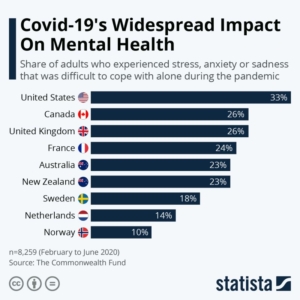Mental health in a workplace
October 2020
Last week, Harvey Nash and KMPG released the results of a global CIO Survey revealing important insight about the future of work. The vast majority of IT leaders consider spending IT budgets not only with their typical stuff as cybersecurity and IT network but 84% of global CIOs and senior leaders concerned with mental health in their teams.
Covid-19 is a game-changer in many aspects. Remote teamwork is a new business imperative. Covid-19 has had a dramatic effect on everyone’s mental well-being. Those who have continued in their roles have experienced a wave of pressure both from the job and its changing demands on them and externally through personal, emotional, or financial consequences of the pandemic. (The Harvey Nash / KPMG CIO Survey 2020).

Recent study An Integrative Total Worker Health Framework for Keeping Workers Safe and Healthy During the COVID-19 Pandemic (Dennerlein et. al, The Journal of the Human Factors and Ergonomic Society, June/2020, available online) summarizes 6 key principles how to support a healthy workplace environment. We are citing the main 6 rules and recommendations below from this great study.
Leadership Commitment
Leadership commitment is driven by clear, consistent, transparent, and empathic communication to all workers from all levels of management regarding policies, programs, and practices that protect workers from COVID-19 (Lord et al., 2017; Quelch, 2020). By doing so, leadership demonstrates that the organization places a high priority on worker health and safety, which sets the stage for ensuring accountability and support across all levels of the organization. These communications need to be supported by clear and consistent actions and implementation of new policies by leaders demonstrating these values by providing a supportive work environment while remaining calm and compassionate. Communication content should be verified for accuracy and developed based on public health recommendations and guidelines for best practices.
Focus on Working Conditions
The approach starts with a focus on working conditions and policies that impact these conditions. Working conditions are central to effective infection control in the workplace. Grounded in workplace safety and health’s hierarchy of controls (Levy et al., 2017), effective infection control reduces worker exposure to the coronavirus. This includes engineering controls such as increased ventilation of fresh air and high-efficiency air filters to reduce airborne pathogens (Allen & Macomber, 2020). Separation methods such as the use of physical barriers between workers and customers at retail checkout stations provide similar controls on potential exposure. The hierarchy of controls model also includes administrative controls to allow physical distancing between workers, coworkers, clients, and customers. These can include scheduling policies that reduce workers’ contact with customers or clients; for example, scheduling retail workers to restock shelves during hours closed to customers or scheduling the same workers to the same crews/shifts. In addition, providing adequate access to handwashing facilities at work and providing personal protective equipment for workers and customers/patients (e.g., face shields, masks) provides the last layer of defense in the hierarchy. In addition, employers may provide additional resources to ensure the safety and health of their workers. As improved testing becomes available, ensuring adequate testing and contact tracing will provide an additional resource to ensure worker safety.
Implementing supportive policies and encouraging workers to use these policies can have a profound impact on workers’ physical and mental health (López et al., 2019). Sick leave with pay allows those who are sick to stay home with financial and job security and also protects the health of other workers. Implementing leave-sharing lets employees with accrued paid time-off give some of that time to others who have exhausted their own. Other policies around scheduling breaks and using personal, sick, or vacation time can relieve the stress of balancing work with greater personal obligations, especially when schools are closed, or relatives may be ill or at high risk or forced to quarantine.
Supportive working conditions can address the increased psychological demands on essential workers. These workers face many threats to their psychological well-being, including fear of exposure, the worry of taking the disease home, stress related to increased work demands and pace, and balancing work with increased personal responsibilities such as childcare. Providing flexibility with breaks, alternative scheduling, using participatory approaches, and clear and accurate communications provide a supportive social environment that addresses the extra demands on the workers (Hurtado et al., 2015). In retail settings, policies for customers to wear masks can help workers feel supported. Ensuring consistent and regular breaks provide opportunities for restoration and stress reduction.
Participation
Employee participation in decision making facilitates a broader culture of health, safety, and well-being within any organization. Participation creates a mechanism for workers to provide information to the organization. Effective and sustainable organizational functioning during COVID-19 relies upon employees feeling empowered to identify safety hazards and threats without fear of retaliation (Punnett et al., 2013; Rivilis et al., 2008). Essential workers on the front lines have extra burdens related to the fear of exposure and adapting work to meet new requirements, which adds a huge amount of stress—understanding how these burdens impact them and their ability to remain healthy and safe while continuing to perform their duties can inform workplace improvements beyond simply meeting the requirements. Employees have the best understanding of how the current work environment impacts them and how it might be improved. When managers listen to employees, it can promote the development of innovative and simple workplace improvements (Hofmann et al., 2017). Being heard may reduce workplace stress as it empowers workers and increases feelings of camaraderie and team cohesion. A simple approach may include having a short huddle with workers to ask three questions: (1) What’s going well and not so well with your health here today? (2) What about work is impacting your health positively and not so positively? (3) What can the team/unit/employer do to help your health and well-being?
Comprehensive and Collaborative Strategies
Many parts of an organization can influence working conditions that in turn impact the transmission of COVID-19, as well as support workers’ well-being during the pandemic (McLellan et al., 2017; Sorensen et al., 2013). Different functional units of an organization, such as janitorial services, inventory management, sales, and shipping, will benefit from working together to understand the impacts on others’ jobs and how they can help one another. Collaborating horizontally within an organization through the use of safety and health committees or a specific COVID-19 task force can coordinate efforts that support all of an organization’s workers (Davis et al., 2014; Dennerlein et al., 2017).
Adherence
While both ethical norms and legal standards are changing quickly as communities and governments enact sweeping rules to stem the spread of COVID-19, adhering to worker safety and health standards provides a starting point to protect their workers. Organizations must follow existing and evolving standards and recommendations from governmental agencies for reducing the risk of transmission. In addition, adhering to wage and benefit requirements, especially sick leave policies and expectations, helps provide a supportive environment for workers. Many governmental and non-governmental agencies are providing resources to help organizations create safer and more supportive environments (MassCOSH, 2020; NationalCOSH, 2020; OSHA, 2020). As standards change, for example with the increased availability of testing, employers need to be poised to respond to new requirements in support of their employees’ health and safety. Respecting the values and beliefs of workers during this time is especially important so that workers will not face added psychological burdens.
Data-Driven Change
Using data to set priorities and form decisions during this time of uncertainty can guide an organization’s efforts. There is a range of data that quantifies levels of risk and can inform planning. For example, monitoring the level of carbon dioxide in indoor air provides an indication of how much fresh air is in the workplace. Using payroll and shift assignment data can identify and plan work assignments to minimize worker exposures to other workers and customers or clients (Sabbath et al., 2018). The wide availability of reliable COVID-19 tests and contact tracing can help identify those employees who need to quarantine and have access to treatment while minimizing exposing other workers. Qualitative data from both managers and frontline workers can identify opportunities and find solutions to improve working conditions, as described above. Data can also be used to measure improvements related to the efforts implemented to reduce the health impacts of COVID-19. Quick short surveys of workers can provide confidential feedback and communicate leadership’s value of worker input. Finally, sharing findings with employees, without compromising confidentiality, is critical in developing trust. Seeing the success and positive changes may boost employee morale and increase motivation to be engaged at work during this challenging time.
Where does Sociomapping come from?
Our CTO, Cyril Höschl, PhD., and Associate Professor Radvan Bahbouh PhD invented Sociomapping, to visualize interrelationship data. This powerful science, also used by NASA and Army in the military missions, reflects social and team dynamics in a way the human brain can understand, and within seconds. Whether you want to develop a remote, agile, or leadership team, Sociomapping visualizes the current and optimal team set-up and reveals potential issues within collaboration culture.




